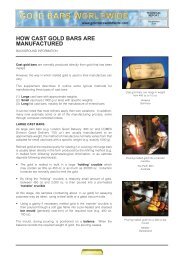Indian Gold Book:Indian Gold Book - Gold Bars Worldwide
Indian Gold Book:Indian Gold Book - Gold Bars Worldwide
Indian Gold Book:Indian Gold Book - Gold Bars Worldwide
You also want an ePaper? Increase the reach of your titles
YUMPU automatically turns print PDFs into web optimized ePapers that Google loves.
TRADITIONAL JEWELLERY RETAILERS<br />
Coins and bars<br />
The proportion of coins and bars received as payment is generally recorded as low. A typical proportion is less than<br />
1% - 2%, but it can be as high as 5 - 10% in some outlets.<br />
While coins were usually used, NRI’s often use small bars acquired from outside India.<br />
Some urban retailers expect the proportion to rise as some of their customers are buying more coins for accumulation and<br />
gift purposes than in the past. They anticipate that more than 50% of these coins will eventually be converted into<br />
jewellery.<br />
BUY-BACKS FOR CASH<br />
The buy-back of old jewellery for cash is significant, but extremely difficult to quantify nationally.<br />
The variation among retailers is marked, even in the same locality. Some also confused buy-backs for cash with exchange.<br />
In some cities (notably in Mumbai), independent scrap merchants also account for a significant amount of buy-backs.<br />
In 2001, among large urban retailers, buy-backs as a percentage of gold jewellery sales were reported to range between<br />
1% and 10%.<br />
Among rural and smaller urban retailers, it ranged between 5% and 40%.<br />
During visits to the west and south in May 2002, however, almost all urban and rural retailers observed that the level of buybacks<br />
had increased significantly due to the high gold price, in some cases the percentage exceeding 50% of gold jewellery<br />
sales. When combined with an increased level of exchange, at times some had no need to buy TT bars.<br />
Anecdotal evidence suggests that in 2001 buy-backs nationally may have been as high as 10% of gold jewellery sales.<br />
A conservative estimate is that it was around 7%.<br />
It can be stressed that many retailers find it difficult to differentiate precisely the split between old jewellery, coins and bars<br />
acquired through exchange and through buy-backs for cash. The important point is that recycling in all its forms is<br />
substantial, and in 2001 appears to have provided 40% or more of the gold used for jewellery fabrication.<br />
General retailer comments on the nature of buy-backs, and the propensity of customers to sell their old jewellery, can be<br />
recorded.<br />
• Urban high and upper middle classes (includes large farmers) do not normally sell back their jewellery.<br />
• Middle and lower classes in urban and rural areas tend to sell back old jewellery, including wedding jewellery, when there<br />
is an economic “necessity” to do so.<br />
• Most customers, who sell back jewellery, would try to replace some of the jewellery when their financial circumstances<br />
improved.<br />
• Although the selling back of jewellery is more common in rural areas, many farmers also use their jewellery to secure<br />
loans from moneylenders and banks. This practice inhibits the level of buy-backs in some States.<br />
• Rural buy-backs also tend to be sporadic. Farmers tend to sell back more jewellery during the monsoon season to cover<br />
family costs when little or no agricultural income is generated.<br />
• In the view of some retailers, customers tend to plan their selling back (unless an emergency occurs such as the need<br />
for medical treatment) to coincide with a known future expenditure. If the gold price rises unexpectedly, many would<br />
take the opportunity to sell sooner the jewellery that they would have sold anyway.<br />
Retailers observe generally that their level of buy-backs over the period 1998 - September 2001 was relatively stable. The<br />
higher level of buy-backs (and exchange) in the first half of 2002 is mainly the outcome of gold jewellery’s sensitivity to a<br />
significant increase in the gold price.<br />
A scrap dealer in Mumbai buying back old gold jewellery for cash when the gold price spiked in May 2002.<br />
AN INTRODUCTION TO THE INDIAN GOLD MARKET 109

















